Bellevue is in the process of updating their 2009 Pedestrian-Bicycle Plan with some new sweet projects. However, there should be some major policy changes as to how Bellevue addresses basic bike infrastructure projects. Here are just a few ideas that could go a long way to make biking better.
1. Buy some green paint
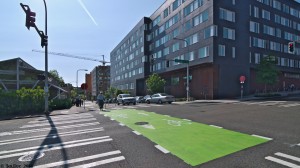
Green paint serves to indicate the priority of vulnerable users at conflict points between bicyclists and motorists. These are particularly useful at intersections, driveways, and lane merges (a very common feature of Bellevue’s many right-turn only lanes) across bike lanes. When motorists see green paint, they tend to be more aware of bicycles and look out for them. Many conflict areas exist in Bellevue, and they could be made safer with some green paint.
Green paint also serves to create bike boxes at intersections. Bike boxes are staging areas for bicyclists, and allows them to be more visible to vehicular traffic. Bicyclists also get a headstart at light cycles, improving their safety. Bellevue’s first bike box was recently installed at NE 8th St and 112th Ave NE. The City is now planning one more at Main Street and 108th Ave NE.
2. Get a good steep hill bike policy
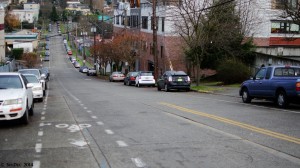
Bellevue has many hills, perhaps even more than Seattle. This means that downhill bicyclists can go fast while cycling uphill tends to be very slow. When going down hills as fast as motorists, bicyclists are safer if they take the lane and don’t allow any cars to pass them. Sharrows in the center of the lane are best to direct cyclists to a safe position.
However, since bicyclists tend to go much slower than cars when going uphill, it can be annoying to drivers to still have bicyclists in the general purpose lane. In those situations, it is less stressful for both bicyclists and drivers if an uphill bike climbing lane is provided. Uphill bike climbing lanes can be wider than regular bike lanes to allow bikes ample movement when out-of-the-saddle or passing other bicyclists.
On many Bellevue streets, bike lanes are provided both up and down hills. It would be safer to get rid of downhill bike lanes on steep streets and use that space to separate and widen the uphill bike lane.
3. Provide sharrows where bike lanes can’t fit or bikes need to take the lane
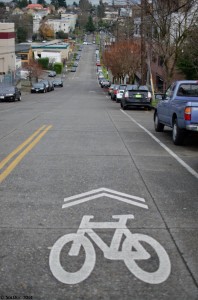
Bellevue is notorious for having drivers that don’t understand bikes must sometimes take the lane, or place themselves at a safe distance from parked cars. Sharrows warn drivers about bicycles and indicate that they should be taking the lane. Sharrows also direct cyclists to the correct place on the street.
On streets without bike lanes, center refuge islands often create narrow lanes (less than 11 feet) that do not allow bikes and cars to pass safely. However, some drivers still try to pass cyclists if they stay too close to the curb. Using sharrows in these cases will help indicate to bicyclists that they must take the lane. This will make a safer street for all while reducing collisions or near-collisions.
4. Turn bike lanes into cycle tracks
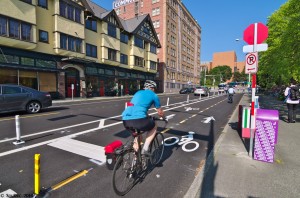
Since Bellevue does not have on-street parking on arterials, bike lanes generally extend all the way out to the curb on either side of the street. Re-striping the same bike lanes on one side of the street with a buffer–gained from reducing lane widths from the standard 11 feet to 10 feet–reduces speed and better protects bicyclists. This also makes riding in the bike lanes much more attractive.
Center planting medians can be an obstacle to this on several streets, but as streets are repaved it will become natural to shift them to create protected bike lanes.
5. Create a Safe Routes to School program
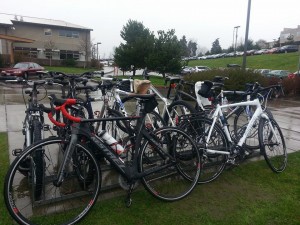
Bellevue has one of the only large school districts in Washington that does not have a Safe Routes to School program. Such a program would teach students how to bike safely to places–like school while young drivers would learn how to behave around bicyclists. The program could also be used to issue mini-grants for better bike infrastructure like bike shelters or curb bulbs. Having more students bike would be beneficial to Bellevue by cutting down congestion and improving student health.
6. Work on driver education
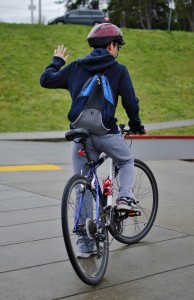
Since bikes were not very common on Bellevue streets until recently, many drivers still do not know how to behave with bicyclists. And, new drivers are not even being taught about how to interact with them. Being a high school student, I talk to many people taking driver’s education course who complain about not being told about bikes. Few people have–or will–an understanding about how the right turn and stop signals are done with the left hand, for instance.
Many drivers also commit faults without being aware of them, such as passing cyclists too close, overtaking bikes right before a traffic signal, or drifting into the bike lane unconsciously. Better driver education could have major positive impacts on how drivers and cyclists interact.
7. Tie bike facilities into a network
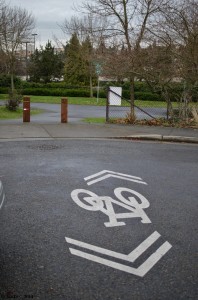
Bellevue has many great pieces of infrastructure, but too many are not continuous and thus do not provide an easy-to-use network. Bike lanes end abruptly and later pick up, or trails have no signage to other streets. Connecting bike facilities together and signing them appropriately will get Bellevue truly useful bike infrastructure, rather than bike lanes that were built as street overlays happened.
The non-existing connection between the future 116th Ave NE bike lanes and the bike trail on the NE 12th St overpass comes to mind as a real opportunity.
8. Use neighboorhood greenways as bike routes
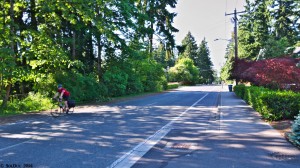
As a suburb, Bellevue does not have Seattle’s great street grid that allows for easy travel though low-traffic streets, known as Neighborhood Greenways. Streets are often disconnected and deadended. However, many low-traffic streets still exist, and they should be made more comfortable for cyclists. 108th Ave NE outside of Downtown Bellevue, the Lake Hills Greenway east of 164th Ave NE or the Kelsey Creek Greenway (between 128th Ave NE and 132nd Ave NE) in Wilburton are examples.
Other deadends can be connected using short trails that restrict car travel while allowing bikes and pedestrians through.
9. Build protected bike lanes Downtown
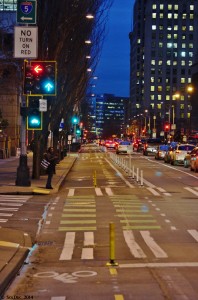
Downtown Bellevue is a major job, retail, and residential center. It makes sense that this is one of the top destinations for bicyclists in the city. While bike access to Downtown is generally good, no bike infrastructure is actually provided in Downton. The last-mile of many bike trips should be just as protected as the rest of the trip. Bellevue should build a network of two-way protected bike lanes in Downtown to accommodate bicyclists in addition to cars. The City should 108th Ave NE between Main St and 12th St NE, and 12th St NE from 108th Ave NE to 112th Ave NE, top priorities. A connection from 12th St NE would integrate well with the existing bike facility across I-405.
Over time, it would be optimal to see north-south cycle tracks on Bellevue Way, 108th Ave NE/SE and 112th Ave NE (north of NE 6th St) and east-west protected bike lanes on NE 12th St, NE 6th St and Main St.
10. Expand the multi-use, off-street trail network
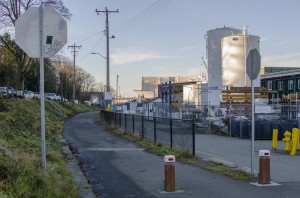
Bellevue currently has two major off-street trail projects. The first is the Mountains-to-Sound Greenway. The City plans to extend the I-90 trail all the way from its current end in Factoria to the city limit with Issaquah at Lakemont Boulevard. The second one is the north-sound Eastside Rail corridor. This new trail will link Bellevue with Kirkland and Renton. Both projects would be beneficial to biking, but multi-use trails can do more than just this.
Several streets in Bellevue have both bike lanes and sidewalks. However, both are sparsely used in some places. These could be converted to wide, multi-use trails on one side of the street, separared by a planted (generally trees) buffer from traffic. Such trails would be a win-win-win situation, as it would provide separation for bikes and pedestrians, and make the street safer by reducing crossing width and speeding (though trees), as well as putting all the bikes and pedestrians in one spot.
Lucky number 11: Convert shoulders to bike lanes
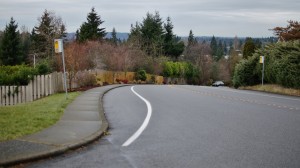
The only difference between shoulders and bike lanes is that cars are allowed to be parked in shoulders, but not in bike lanes. On many streets in Bellevue, shoulders exist but are not labeled as bike lanes. Since cars do not regularly park on many of those arterials, this does not pose a problem, except when a car does decide to park in the shoulder. This forces the bikes into traffic without a safe transition between the shoulder and the travel lane. Designating shoulders as bike lanes, especially on streets where they are narrow or on hills, would make a good, cheap bike safety improvement.
Guy is a high school student in Bellevue with a strong desire to become an urban planner. Before moving to Bellevue, he grew up in the Paris metropolitan area where he fell in love with and learned from some of the best rail systems in Europe. Translating his experiences from abroad to Seattle, Guy is now passionate about improving this region's public transit (especially marine-based transportation) and cycling infrastructure. Aside from the technical side of things, Guy also enjoys photography and music.


